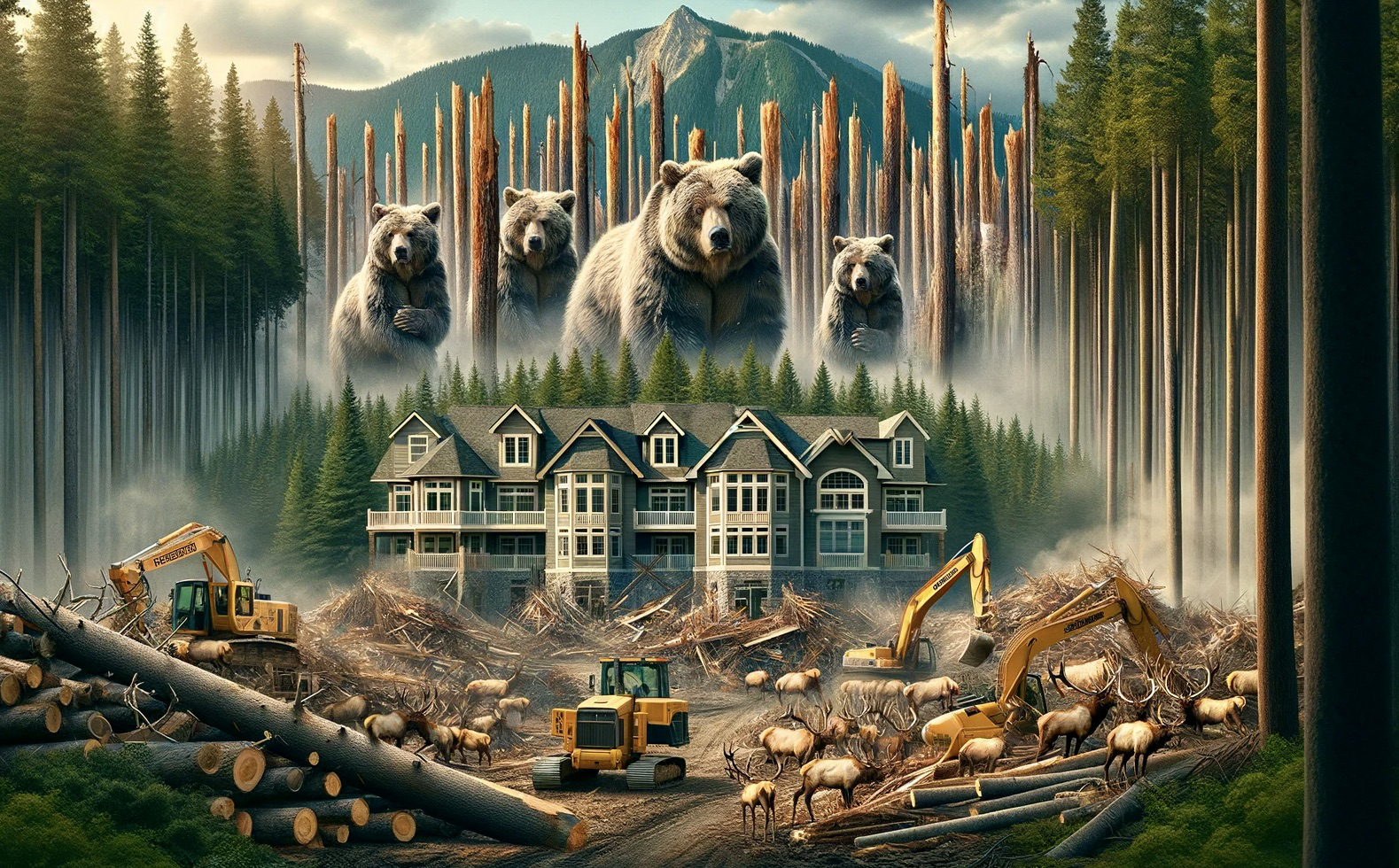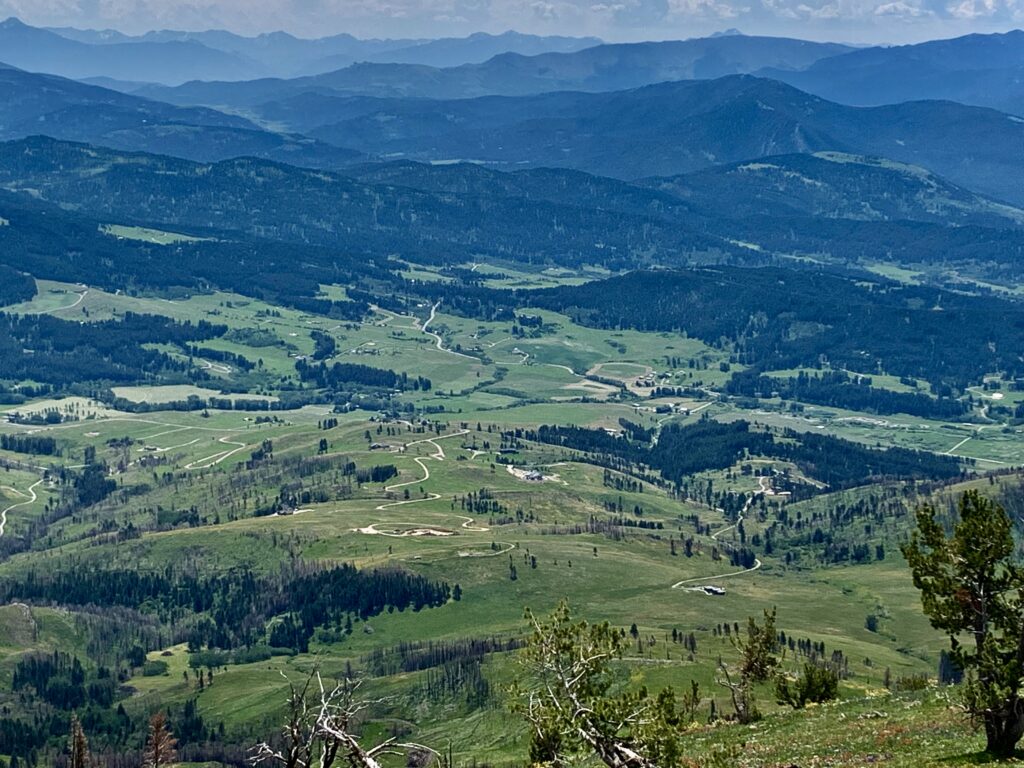By Todd Wilkinson
In 2024, the sprawling resort community of Big Sky, Montana turned 50 years old. Among a year’s worth of celebratory festivities, there was plenty of back slapping and self congratulations that flowed back and forth between realtors, developers, and capital investors who have enjoyed a multi-billion-dollar bonanza in recent decades based on the monetization of private land in an important part of the Greater Yellowstone Ecosystem.
At just half a century old, one could argue that Big Sky is, by economic metrics, a juggernaut. In 2020, the Big Sky Economic Development Profile stated that Big Sky is the fastest growing resort community in the country. Its population has more than doubled since 2010 and it grew 11 times faster than Aspen in Colorado and 12 times faster than Jackson Hole in the center of Greater Yellowstone. From 2019 to 2020, the total value of real estate sold year over year more than doubled as more people fled to Big Sky and other rural hideaways during Covid.
Breathtaking is to consider is that developers in Big Sky proudly say “the community” is only at around 65 percent of buildout.” Telling is that no one seems willing to reflect very hard on what price nature has already paid to date for Big Sky’s large ecological footprint, and what the total impacts of buildout will in service to Big Sky’s future “success.”
Also telling is what its adamant boosters omit. Consider this: between two Big Sky Economic Development Profiles prepared for the years 2019 and 2020, thousands of words were written touting the local real estate gold rush. The word “wildlife,” however, is referenced just twice—this in a setting where realtors for decades have sold clients on the dream of living or visiting a Shangri-la where a world-class concentration of wildlife lives harmoniously in the backyard.
How well has that worked out? You never hear or see the local media looking very hard to find an answer, nor, do a growing chorus of concerned citizens say, do you find many conservation organizations talking about Big Sky’s cumulative effects which have arguably made it a poster child for where not to have unchecked sprawl.
According to more than a dozen wildlife, conservation and planning officials Yellowstonian interviewed, Big Sky is a useful reference point—and cautionary tale—for other natural areas in Greater Yellowstone and the West staring into the face of growth because it illustrates what happens to wildlife when its importance is minimized, and when there is no cohesive, methodical strategy for managing sprawl in a way that keeps long-term ecological objectives in mind.
It’s what happens too when there is no municipal government, coupled with a serious lack of oversight and zoning applied by county governments. Big Sky, which is not officially a town in Montana, has evaded the latter because of a fluke of geography that places part of it in Gallatin County and the other in Madison County.

Today, the US Highway 191 corridor extending southward from the tiny town of Gallatin Gateway, Montana in the Gallatin Valley a few dozen miles north of Big Sky is one of growing visual blight and fragmentation on private land caused by sprawl, much of it owed to Big Sky’s expanding tentacles of influence.
US Highway 191 is well known for being a dangerous roadway and it’s one fraught with a sizeable number of vehicle-wildlife collisions. According to a new report from the Center for Large Landscape Conservation, the entire stretch of highway from Gallatin Gateway to Big Sky is problematic. Just a single 10-miles stretch alone has notched the second highest frequency of recorded ungulate carcasses (whitetail and mule deer, elk, pronghorn, moose, and bighorn sheep) per mile in Montana. Other species have been run over too.
Some Big Sky community leaders suggest that an easy fix is building wildlife overpasses and underpasses along the route. Those pleas, however, seem to come with little visible reflection on the fact that the source of the problem, in large measure, is development emanating from Big Sky, radiating northward through the Gallatin Canyon into the Gallatin Valley; sprawl expanding with spartan deference given to wildlife and leading to rising traffic levels as compounding contributors to the toll. Again, the media and reporters based in Big Sky have applied little scrutiny to pondering the big picture. It causes one to ask why?
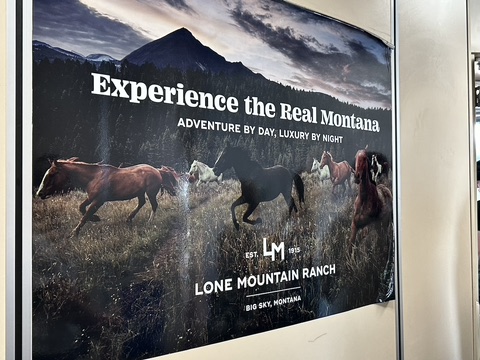
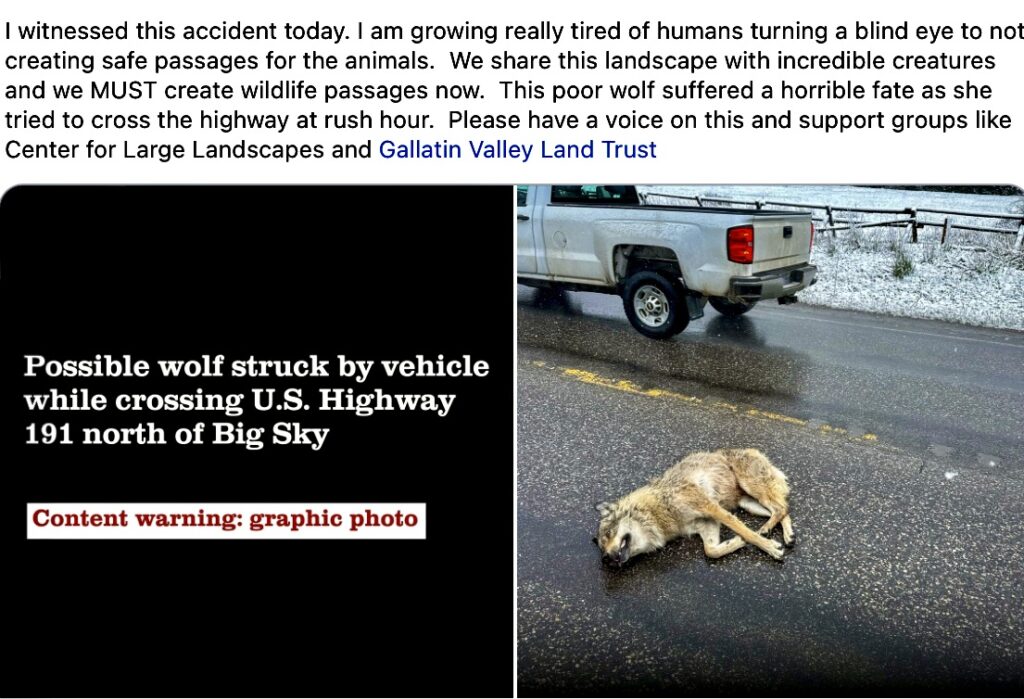
————————————————————————————————————————————————————
Vital to consider is Big Sky’s context within a bigger picture with parallels that can be drawn to valleys on both sides of Big Sky—Paradise Valley just over the Gallatin Mountain Range to the east; and the Madison Valley, on the other side of the Madison Mountain Range to the west. Both are highly vulnerable to the same kind of develop-at-all-cost mentality that still seems to thrive in Big Sky.
In mountain valleys of western Montana and Greater Yellowstone, people are arriving in relative droves, leaving distant cities based on a perception that what these places offer is quaint, care-free and special. Professional land use planner Randy Carpenter has been tracking growth in Greater Yellowstone for decades. He says that, ever increasingly, many who hail from distant burgs are upwardly mobile and often politically conservative. And they’ve convinced themselves they need another or different home on the range where they can go, ostensibly to live closer to nature while escaping regulation that’s necessary to protect the local environment.
Wooed by blithe-sounding real estate ads, they’re motivated to seek dreamy Shangri-la playlands, trout waters reflecting bluebird skies and ski runs holding waist deep power. What many new arrivals lack is any deep understanding of how the natural wild world really works—what’s necessary to keep it that way.
Being able to see wildlife in magnificent landscapes as part of our daily lives in Greater Yellowstone is not just a rare attraction appealing to newcomers—it is inherent to our local identify and quality of life. As polls suggest, it ranks high on the list of values that inspire those living in southwest Montana. Similar sentiments are shared in many places in our bioregion, from Sublette County near the Wind River Range in Wyoming northward to the dales surrounding Glacier National Park in Montana along the Canadian border. They’re present, too, in the Madison and Centennial valleys on the west side of Greater Yellowstone and in the Bighorn Basin east of Cody and, of course, in Bozeman (one of the fastest growing small cities in the country) and the twin booming Teton counties of Wyoming and Idaho. They were part of the reason others went to Sun Valley, Whitefish, Steamboat Springs, Park City and even Vail, Aspen and Durango.
Gallatin Gateway is a place that touted itself as an early gateway to our oldest national park, Yellowstone, through the Gallatin Canyon that holds upper reaches of the main Gallatin River which originates in the mountains of Yellowstone.
___________________________________________________________________________________
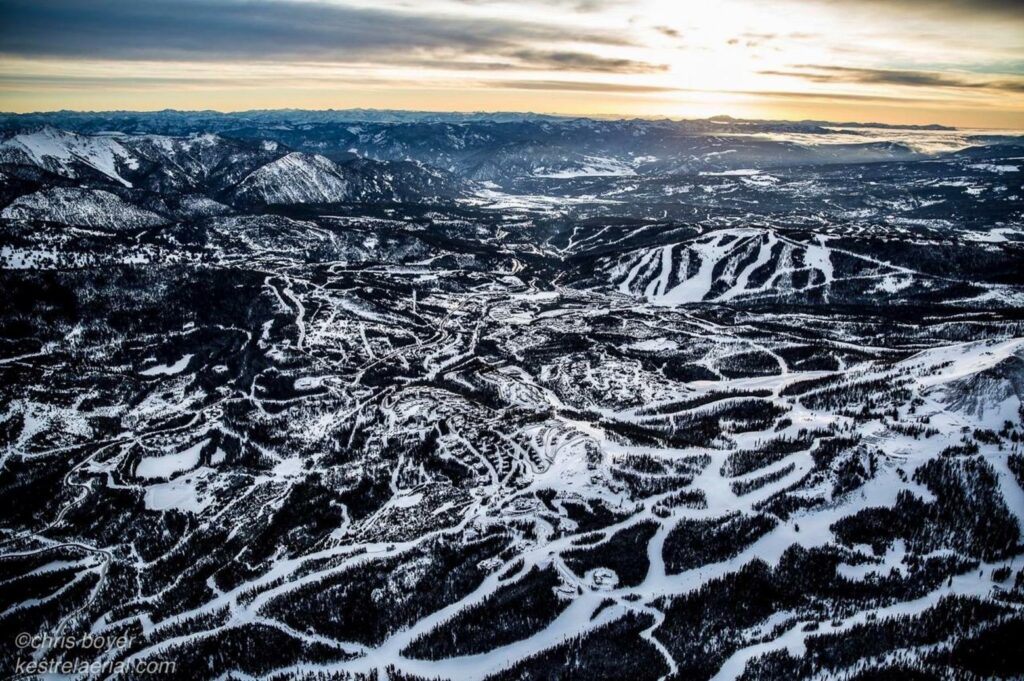
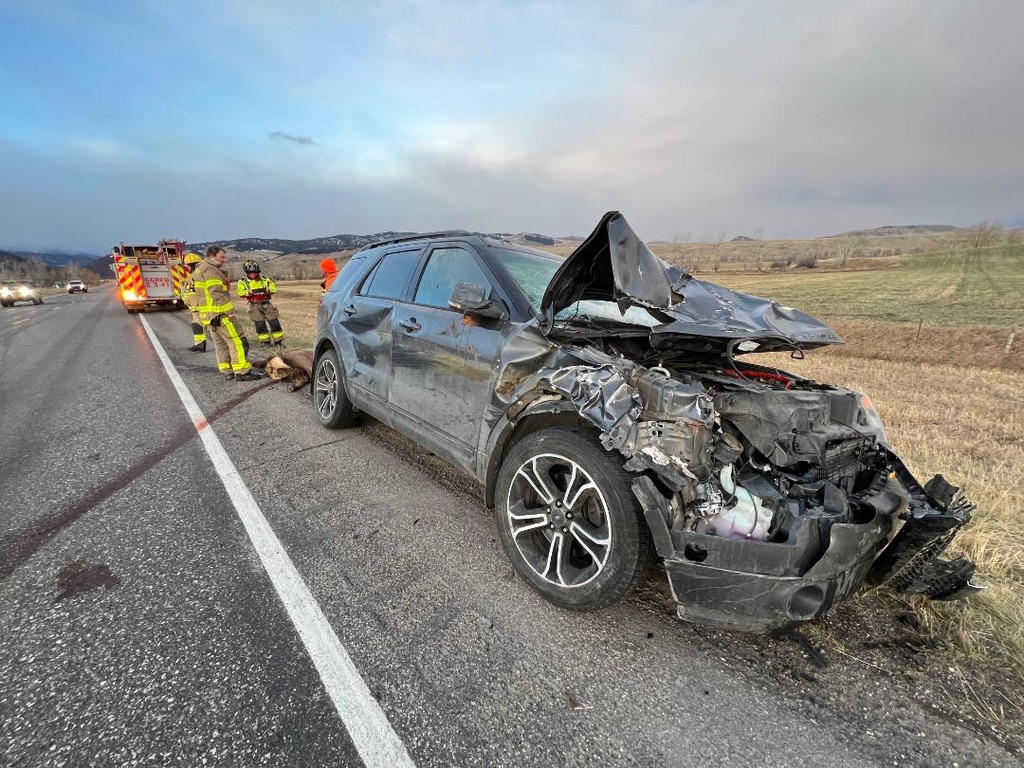
___________________________________________________________________________________
I recently spoke with Bud Griffith who for years managed the Flying D Ranch owned by Ted Turner. Turner has owned the Flying D since the late 1980s and he put a conservation easement on all if its 113,000 acres. Today it’s an incredible home for a diverse range of pubic wildlife living side by side with Turner’s 5,000 privately owned bison. Griffith was celebrated this winter at a community event in Gallatin Gateway. He remembers a time before Big Sky; when there was really nothing in terms of large human presence in the West Fork of the Gallatin River drainage set at the foot of Lone Mountain.
“A few dude ranches were in the area along the main Gallatin [River] and cattle were run in the hills and some timbering done on the checkerboard lands belonging to Burlington Northern [railroad],” he said. In the 1950s and 60s, Griffith guided big game hunters throughout the meadows and forests encircling what’s now Big Sky in pursuit of elk and bighorn sheep. “There was a good sized elk herd there,” he added.
A blue-ribbon report released in 1970 by Montana Fish Wildlife and Parks and titled “People and the Gallatin Elk Herd” identifies how beloved that particular wapiti population has been historically to the identify of Montanans. Early in the 20th century, Gifford Pinchot, first chief of the US Forest Service, recommended that it be specially protected and in 1911 the state of Montana designated land for that purpose in the southern Gallatin mountains. The 1970 report from Montana Fish Wildlife and Parks emphasizes the importance of quality habitat to safeguard seasonal elk movements and herd heath, and it specifically references the West Fork of the Gallatin, the South Fork of the West Fork of the Gallatin and Deer Creek as providing vital seasonal terrain for elk moving out of Yellowstone and the Gallatin Range from the east.
“Lying in some of the most rugged, most beautiful and coldest terrain in the United States, the Gallatin Canyon widens slightly in its midsection allowing room for an elk winter range. Deep snows in the fall and winter force elk from high mountain meadows within Yellowstone into this Gallatin Basin or Upper Gallatin Valley,” the report reads. “The elk winter along the river and its tributaries from about Specimen Creek to Taylor Fork and Porcupine Creek. At times they winter lower during severe winters to West Fork and portions of Deer Creek. The elk are discouraged from moving completely out of the mountains and into the lower valley by the precipitous and rugged lower portions of the canyon, which is bounded on the west by the great mass of the Spanish Peaks and on the east by the deeply cut and heavily timbered drainages of Levinski, Portal, Moose, Swan, and Squaw Creeks.”

The above is important for several reasons. First, it speaks to the vital historical importance of Gallatin Canyon and side drainages in supporting the persistence of one of the most famous elk herds in America. Second, it emphasizes their role as key winter ranges where elk go to find refuge during the harshest of winter conditions when food is scarce and the going is tough. Third, it explains why natural geology prevents elk from being able to range more widely in winter owed to natural pinch points. Fourth, this context illuminates why merely installing wildlife overpasses and underpasses across US Highway 191 is not a panacea.
Lastly, when the report was published in 1970, Big Sky did not exist but today it sits directly on top of elk winter range that helped sustain a herd considered a state and national treasure—habitat that supported elk and numerous other species. In order for winter range to serve its ecological function, it is essential that it not be fragmented and that the animals on it not be disturbed. In the last 50 years, there may not be a starker example of how habitat on private land for an iconic animal has been more thoroughly disrupted. Far from wildlife carnivores or human hunters being the biggest, most ferocious predators of elk, mule deer, bighorn sheep, moose and pronghorn, the most formidable, incessant and ultimately population-depleting is sprawl. It never goes away.
The late airplane pilot Roger Stradley, who flew thousands of aerial overflights for biologists to survey and count wildlife in Yellowstone Park and nearby valleys told several scientists of how he remembered returning to Bozeman in winter and seeing huge numbers of elk in and around Big Sky prior to the resort being built. He lamented how they steadily winnowed as intense development set in.

Another, the late Joe Gutkoski, who was the Forest Service’s first landscape architect in the region, told me that during the 1950s and 1960s he often went on successful autumn elk hunts in the vicinity of the Yellow Mule Trail located near to the lands later developed in the 1990s as the Yellowstone Club. After construction ramped up at Big Sky in the early 1970s, the behavior of elk changed and the experience wasn’t the same, he said. Gutkoski abandoned his own hunting haunts and focused on hunting elk across the US Highway 191 in the Gallatin Range on public Forest Service land.
In the late 1950s and 60s, Bud Griffith told me, he occasionally encountered grizzly bear tracks in the vicinity of what is Big Sky. Grizzlies were rare then, their numbers reduced from hunting and killing to protect livestock. However, retired federal grizzly expert Chris Servheen said if the country had remained in the same shape as when Griffith encountered it, bears would be thriving there today. That potential future evaporated when Chester Robert “Chet” Huntley, who grew up in Cardwell, Montana and gained fame as a news reader on broadcasts of the NBC Nightly News, had a dream. He envisioned a ski area that would benefit Montana and show off the state’s scenic splendor. Not possessing the financial means himself to executive the vision, he enlisted investors to create a downhill ski area on the slopes of Lone Mountain in the West Fork of the Gallatin.
Huntley and his partners knew real money wouldn’t be made selling lift tickets. Fortunes could be amassed instead developing lots at the base. Skiing was just the magnet. Big Sky has turned into a giant that grew up on a steady diet of eating wildness and it morphed into the mother of all speculative real estate bonanzas in the Northern Rockies. The permanent population of Big Sky is pushing toward 3,000 and it swells to four or five times that number during the busiest seasons when tourists are there in full force and part-timers converge to stay in their vacation homes.
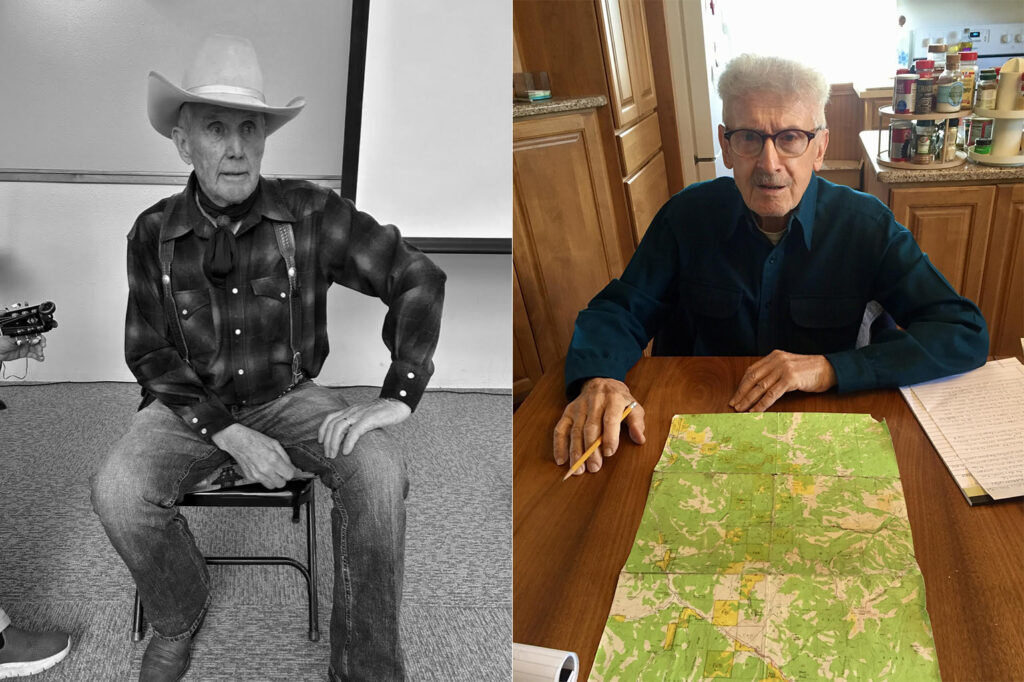
————————————————————————————————————————————————————
“Unfortunately,” a Montana realtor specializing in finding conservation buyers for biologically-important ranch properties told me, “Chet’s concept, which began somewhat modestly then went through a series of distortions and snowballed out of control.” It’s inordinately difficult to retrofit landscapes severely impaired by sprawl just as it strains credulity when, as is being done today, the media in Big Sky and developers, are trying to re-engineer an image that claims protecting wildlife is a priority.
On March 31, 1997, my friend and journalistic colleague Ray Ring wrote a richly-layered story published in High Country News titled “Big Sky, big mess in Montana” examining the kind of wild-west attitude that sowed planning chaos in Big Sky. Ring revealed what happens when there is no municipal government (which remains the case now) and no centrifugal guiding force in thinking about the end game of environmental impacts over time. The piece is a must-read in understanding the psychology of Big Sky and its genesis. Because memories and attention spans in the New West are short and often result in amnesia, Ring offers a counterpoint to all of the nostalgic reflection and self-congratulations occurring now as Big Sky celebrates its half century birthday. The truth is the scramble has transformed an exceptional wild corner of Greater Yellowstone and the Madison Range into a cousin of something one would find along Colorado’s I-70 corridor on the way to Vail.
Completing research for a possible book, Ring spent six months trying to identify where the heart of Big Sky resided around the time timber baron Tim Blixseth arrived and who shrewdly created the Yellowstone Club (playing on the name of the famous iconic national park nearby) and which set in motion an attitude that still persists. By design, Blixseth wanted the Yellowstone Club to stand apart from the modest humble values of everyday Montanans. In a story to come here soon at Yellowstonian, Ring offers a reflection on what Big Sky, in his mind, has come to represent.
Rather strangely, as I was gathering research for this story. I could not find any traditional conservation organization demanding in recent years that the total cumulative environmental effects of Big Sky and its various development entities be assessed. Not one major national or regional conservation group has. Nor has any media outlet since Ring investigated it 27 years ago, though as you will see below a lot has happened in that ensuing span. This lack of attention would not be the case if Big Sky were instead, say, a mining company with intent to disturb even a tiny fraction of the amount of earth that’s been moved within view of Lone Mountain and beyond.
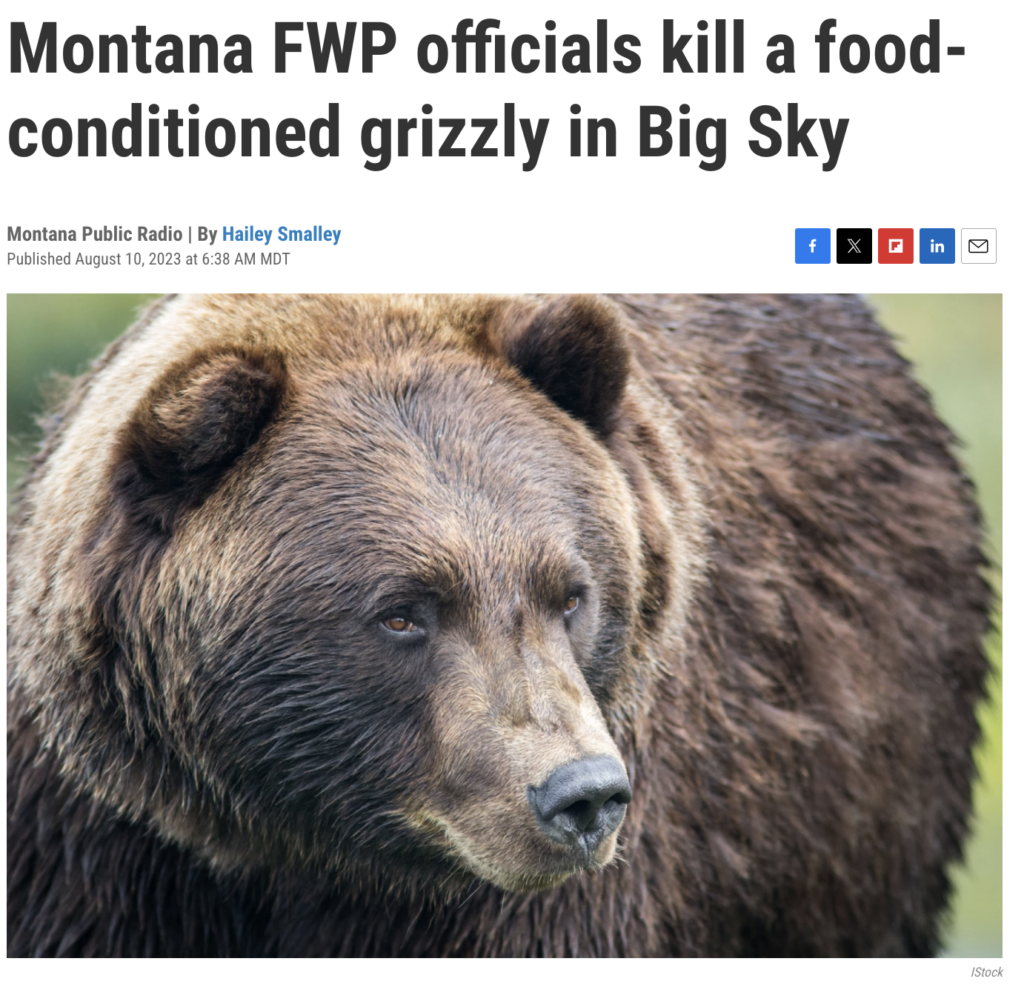
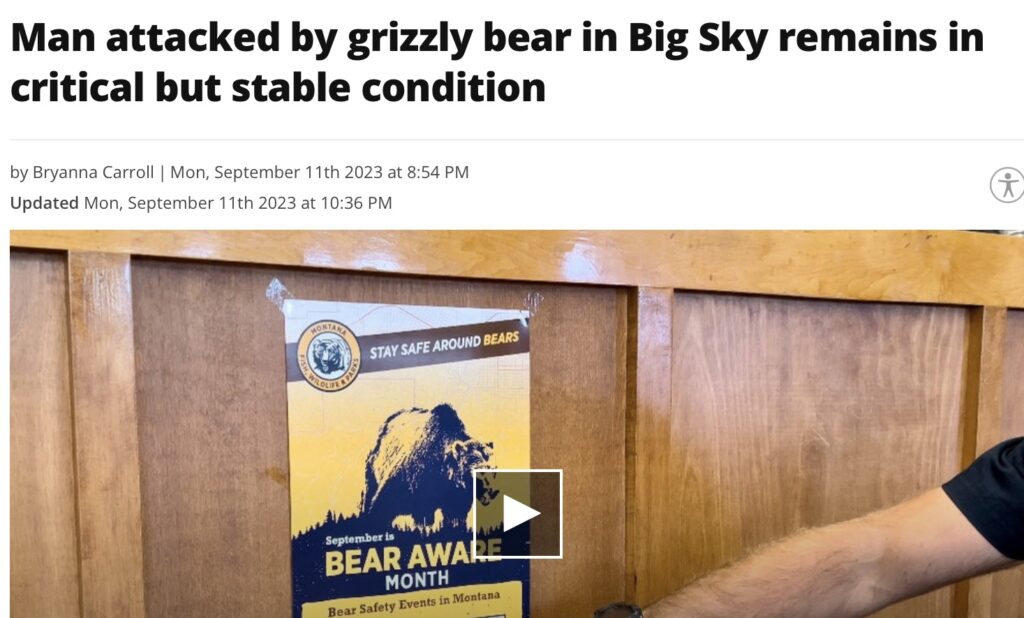
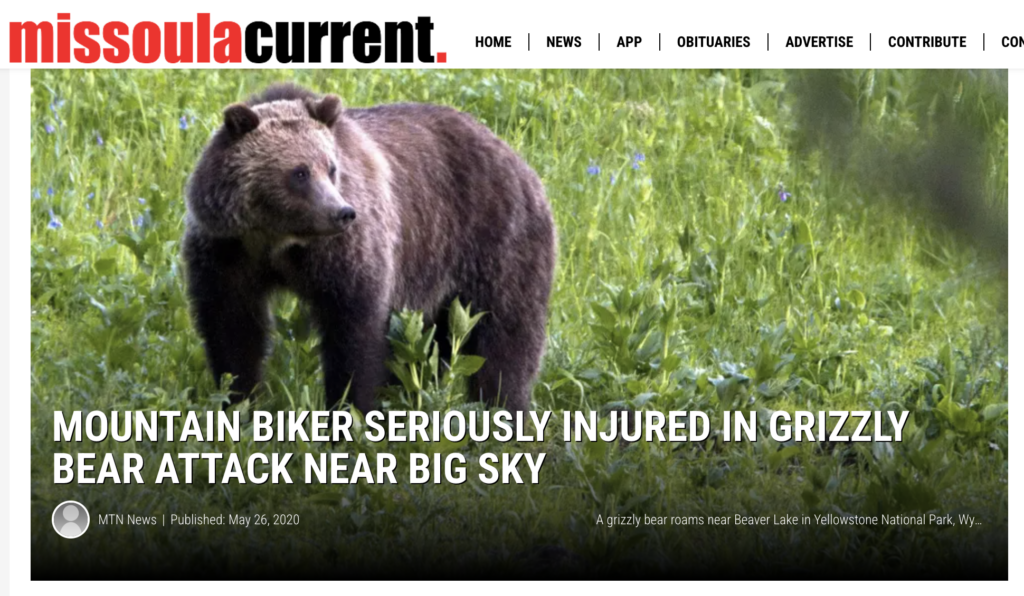
Ponder, for example, its impact on grizzly bears. In 2012, Dr. Charles Schwartz, then head of the Interagency Grizzly Bear Study Team, and scientific colleagues wrote a peer-viewed analysis published in Wildlife Biology titled “Impacts of Rural Development on Yellowstone Wildlife: Linking Grizzly Bear Demographics With Projected Residential Growth.” Big Sky was highlighted in the study. The authors invoked the terms “source” and “sink” to explain the difference between what sustains a healthy population of bears vs. forces that result in animal extirpation.
In biological parlance, a source is a place where animal populations successfully reproduce and sustain their numbers. A sink is an area where, in the case of grizzlies, the death rate exceeds reproduction. In sinks bears get into chronic conflict and are killed or removed due to human factors. Sinks are not friendly places for wildlife. Big Sky, Schwartz and colleagues noted, is one of those. “Development in the Big Sky area already constitutes sink habitat and projected development west of Big Sky in the Moonlight Basin could potentially fracture the Lee Metcalf Wilderness to the north from undeveloped forest service lands and the Lee Metcalf Wilderness to the south,” they wrote, unaware at the time that development was about to erupt even more in both Big Sky and Moonlight Basin.
If one sees Big Sky as an unquaint helter-skelter of sprawl and clutter today that already has generated concerns about future water availability and wildfire danger, and has left in its wake serious water quality challenges including pollution to the blue-ribbon Gallatin River, plus irreversible impacts on wildlife, adjacent public lands and surging traffic on US Highway 191, it’s sobering to discover that much more is planned as developers push toward full “build out.”
° ° ° °
Matt Kidd, managing director of Lone Mountain Land Company has, on many occasions, exclaimed the virtues of growth. In January 2023, he said this in an interview which alarmed some long time conservationists (see their comments below) and residents of Big Sky who fret how sprawl is negatively transforming scenery. “Some might call these challenges growing pains,” Kidd said. ” But it’s a lack of growth that hurts…we’re committed to developing a future that’s in harmony with the beauty of the land that surrounds us.”
“Some might call these challenges growing pains. But it’s a lack of growth that hurts…we’re committed to developing a future that’s in harmony with the beauty of the land that surrounds us. The goal is to nurture everything that the community loves about Big Sky, including open spaces, majestic sightlines, and the shared experience that brought us all here in the first place. Protecting and enhancing the surrounding natural environment is one of our core values.“
—Matt Kidd, managing director of Lone Mountain Land Company
Undeterred by any criticism, it’s full steam ahead and, based on what he said, there will be a lot more construction. “As it [Big Sky] goes from 65 percent build-out today, to 100 percent build-out in the coming decades, the goal is to nurture everything that the community loves about Big Sky, including open spaces, majestic sightlines, and the shared experience that brought us all here in the first place,” Kidd said. “The trick is viewing growth not as a problem, but as a means to address longstanding challenges the community has dealt with since its inception. That’s where the nurturing comes in. Today, we’re in a unique position to be able to do that. Instead of squabbling and infighting, all the major stakeholders—landowners, resort operators, developers, and community advocates—are aligned. We can take a holistic approach to community building. That’s incredibly unique. No other resort town in North America has had the luxury of a shared vision. We do. Protecting and enhancing the surrounding natural environment is one of our core values.”
Everywhere one turns in Big Sky, and prolifically in the PR messaging being churned out by a number of different entities, aspirational words such as “stewardship,” “sustainability,” “holistic thinking,” and “enhancement” are tossed around with wild abandon. In terms of the kind of wild nature that once defined the setting of Big Sky, it’s not clear exactly what is being stewarded, sustained or enhanced.
At a public meeting April 2024, Kidd spelled out a vision for how, in the next 15 years, Big Sky will continue its push toward build out on private ground that is presently undeveloped. To many, vacant land is not habitat, but an asset just waiting for a human purpose. Lone Mountain Land Company is part of a corporate structure that includes Boston-based CrossHarbor Capital Partners which owns the high-end Yellowstone Club, Spanish Peaks and Moonlight Basin gated communities, home to celebrities, business titans and tech gurus whose personal net worth is counted in the hundreds of billions. CrossHarbor acquired title to those formerly-struggling properties, rescuing them from financial distress and bankruptcy and launching Lone Mountain Land Company in 2013 as the vessel holding them.
Prior to CrossHarbor upping its stake in the luxury real estate market and attracting more outside capital, the ski resort itself, a separate entity controlled by Boyne Resorts, was growing skier days at a pace of about 100,000 per decade. Between 2017 and 2023, skier days rose from 500,000 to 700,000 and not only is there a desire to ramp up volume by having more hotel rooms but adding amenities that will make Big Sky a bustling year-round hive.
__________________________________________________________________________________
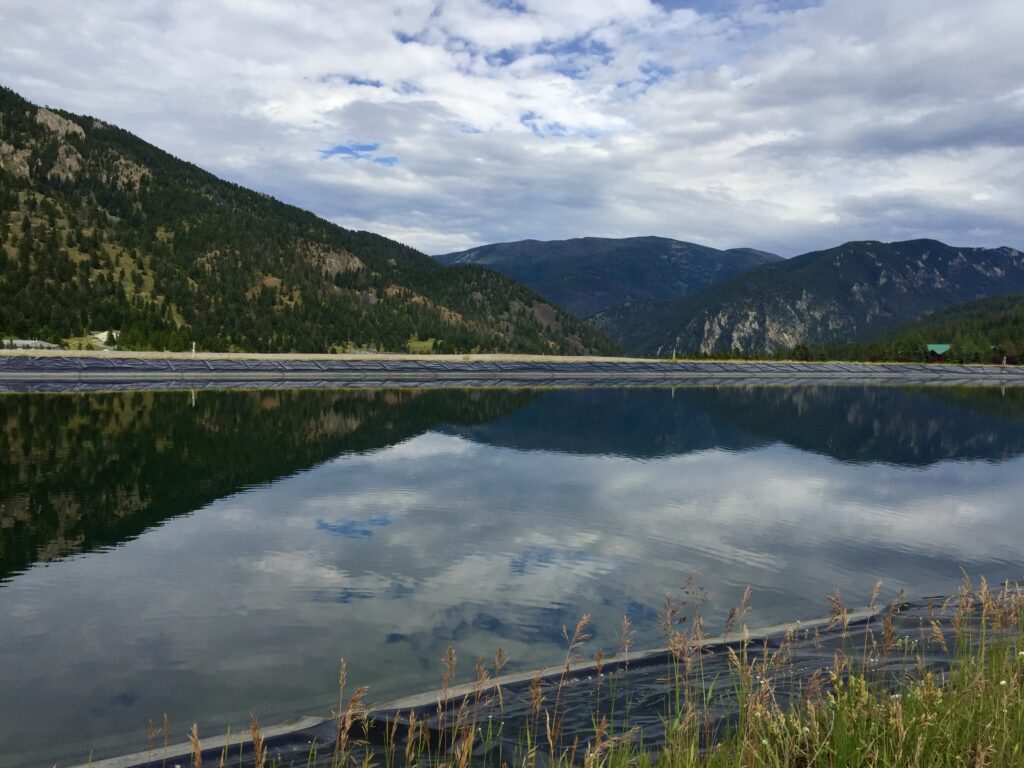

__________________________________________________________________________________
A few years back a bumper sticker appeared on vehicles in southwest Montana and it read: “Big Sky: Where Effluence and Affluence Meet.” According to the Gallatin River Task Force, 40 percent of residential and commercial water users are tied into centralized water and sewer treatment in Big Sky and the Gallatin Canyon, with the rest being on individual septic systems, some of which have been leaking. “To avoid effluent discharge into the Gallatin River, water operators use treated wastewater to irrigate public spaces, community parks, and local golf courses,” the task force says on its website. “A plant upgrade expands reuse options and conserves water in a variety of ways.”
Reuse of treated water soon will enhance the area’s snow-making capabilities. The Montana Department of Environmental Quality issued a draft permit in early May 2024 and described in its environmental assessment what will happen at one of the properties. CrossHarbor-Spanish Peaks proposes to discharge up to 44 million gallons of treated wastewater as artificial snow in two phases: 23 million gallons per year in Phase 1 and an additional 21 million gallons per year in Phase 2. Snowmaking will occur primarily during the early portion of the ski season. Natural snow will accumulate on top of and mix with the artificial snow. The wastewater will be disinfected to standards required for wastewater reuse.
Earlier, the Gallatin River Task Force, Trout Unlimited, American Rivers, Greater Yellowstone Coalition and the Association of Gallatin Agricultural Irrigators endorsed and praised a similar project, launched as a pilot by Lone Mountain Land Company and the Yellowstone Club, to use 25 million gallons available from a new $55 million wastewater treatment facility. DEQ said that by employing twice-filtered recycled wastewater, it lessens the need to to use more fresh water for snowmaking. Although two groups in particular, Upper Missouri Waterkeeper and Cottonwood Environmental Law have expressed concern about nutrients leaching into the river or private wells during spring snowmelt, the state said the water treatment process removes nutrients and other polluting chemicals. The ski slopes themselves are intended to serve as a third and natural filter and among the stipulations highlighted by DEQ for its approval is a commitment to aggressively engage in testing and monitoring.
Here’s the thing: if Big Sky were instead a Canadian mining company forced to build a multi-million-dollar water treatment plant to handle toxic mine tailings, in order to prevent pollution from sullying the Gallatin River, the company would not be praised.
Pollution issues in the Gallatin River have been portrayed as a water treatment issue. Here’s an overview about Big Sky’s water woes written by Quincey Johnson, outreach director for Upper Missouri Waterkeeper, about how the Gallatin can overcome its impairment designation linked to algae blooms. Impairment also exists in the tributaries. Upper Missouri Waterkeeper and Cottonwood Law have argued that it’s actually part of a more complicated growth issue involving development that is generating sullied water that needs to be disposed of, and it has necessitated a new treatment facility. In the years ahead, that plant will need to process huge additional volumes of gray water and water being flushed down toilets replete with illicit drugs and pharmaceuticals that pass through human bodies, as well as water holding microplastics, endocrine-disrupting chemicals, cleaning products and myriad other things that are difficult and expensive to remove.
Plus, water at Big Sky now being pumped from underground aquifers or other natural sources would normally enhance critical flows into the Gallatin during low, warm water months and is essential to maintaining its famous trout population which, in turn, feeds other wildlife. Scientists say that natural precipitation levels and snowpack may be reduced in coming years by climate change, affecting everything from water reaching the Gallatin River to recharging aquifers and providing other beneficial uses for nature. How paradoxically does Big Sky intend to markedly grow the number of humans using water year round in the decades ahead and sustain the quantity of water it needs, and qualitatively still be in compliance with the federal Clean Water Act and state statutes?
If major conservation organizations working in Greater Yellowstone are not actively engaged in planning and zoning issues, then they are not working to stop many of the biggest threats facing this ecosystem, critics say. Big Sky is considered one of the biggest environmental issues. While it’s a private land issue—a planning and zoning issue, it’s a major concern for wildlife and health of nearby public lands. Surprisingly, national and regional organizations have turned their backs on private land sprawl issues at the peril of wildlife and public lands they claim to be defending. The media is largely missing in action, too.
Water issues are linked inextricably to terrestrial issues, as in what’s going on with the land. Back in 1997, Ray Ring alluded to the early mentality that informed decisionmaking and it remains pervasive still with many county governments. He wrote, “What you don’t hear about is the underlying premise: Big Sky is a test site for the idea that government and anything public should be shrunk down to libertarian size, allowing money, private property and market forces to dominate.”
During a recent drive through Big Sky, parts of it looked like a dispersed construction site. “For Sale” signs belonging to real estate companies adorned dozens of lots as I guided a conservation biologist to get his take on the panorama. Many of the available lots appeared to be in steep and densely forested terrain. Besides previous sewage issues, one infamous lawsuit going back more than a decade speaks to the hasty and sometimes less than forthcoming circumstances surrounding the land rush. A developer was sued after a property owner raised concerns that a purchased lot might be situated on a slope prone to landslides. The vice president of design and construction for the developer at the time instructed salespeople via email (divulged in the legal discovery process) to “baffle (buyers) with BS rather than provide actual reports.”
CrossHarbor was not involved in that incident. To its credit, as soon as it assumed control of the Yellowstone Club from Blixseth in 2009, en route to becoming the biggest player in town, its executives publicly promised to restore the reputation of developers and re-instill faith in existing individual property owners and buyers. Their action has obviously restored confidence, bullishly, and the entire real estate community has benefitted from a subsequent frenzy in sales. As of April 2024, the median price of a single family home in Big Sky was $2,499,000, and the median price of a condo $945,000. That average condo value is more than double the value of an average home in the rest of Montana.
Lone Mountain Land Company recently added an area known as “Town Center” to its portfolio of assets. In April, Kidd and Bayard Dominick, Lone Mountain Land Company’s vice president of planning and development, described at the public meeting new waves of development coming down the pike. “Construction plans include multiple hotels and residential areas, a transportation center with parking for buses and vans, commercial and gathering spaces in Town Center Plaza, and a pedestrian promenade connecting the [Town Center] plaza to an outdoor performance space and event barn tentatively called “Bluff Edge Park,’” wrote associate editor Jack Reaney with the local newspaper, Explore Big Sky. “Another concept, northeast of Town Center and tentatively called ‘Cold Smoke,’ could develop two areas of land—currently forested near the South Fork of the West Fork of the Gallatin River—into 125 single-family homes and up to 264 apartment units.”
That’s on top of the $416-million Montage luxury resort that opened in late 2021 further up the mountain and proudly calls itself “Montana’s biggest building.” Montage covers more than 520,000 square feet and has 150 guestrooms and suites that start at a rate of $1,500 per night.
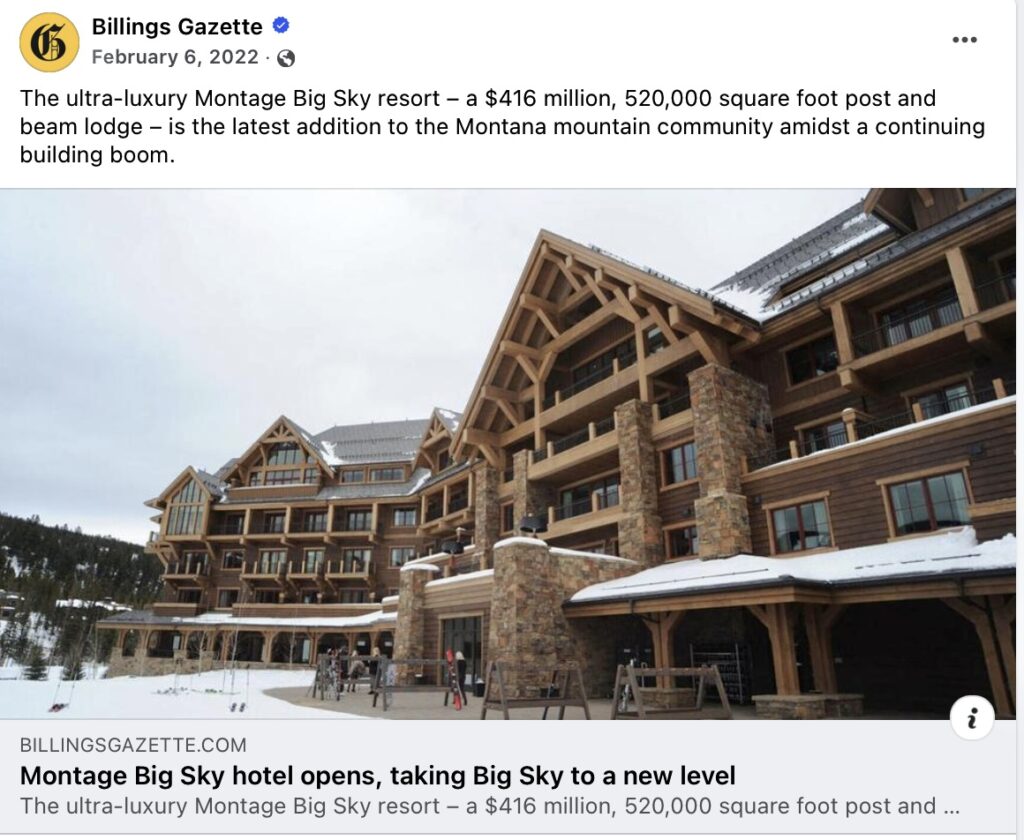
In 2025, another ultra-luxury destination on the northwest end of Big Sky called One and Only-Moonlight Basin, backed by investors from Dubai, will open with a new lodge and 73-room hotel, 19 villas and 62 private “alpine-chic” residences advertised for sale at $8.8 million each. “Nestled within the foothills of Lone Mountain, each home blends seamlessly into the forest landscape,” glowingly wrote a travel journalist for The Robb Report.
To use the language of the Robb Report writer, having numerous multi-million-dollar structures nestled seamlessly into forested, mountainous landscapes may sound poetic, but experts with the US Forest Service and US Department of Agriculture who have assessed wildfire danger levels in hundreds of montane communities in the West have raised alarm about fire danger in many settings. You can check where your own community stands by typing in its name here. The human-built environment in Big Sky, in those agencies’ latest review, was rated at “very high risk of wildfire—higher than 96 percent of communities in the US.” See the graphic produced by those federal reviewers below.
This presents a conundrum: should the landscape now be stripped of its trees to safeguard expensive trophy homes and include thinning that may, in turn, harm remaining forest cover that provides wildlife habitat and factors into scenic appeal? Should insurance companies continue to provide coverage for dwellings that might be hard for firefighters to safely defend? Should more building even occur in the wildland-urban interface (WUI) that local fire and county officials know is at much higher risk to burning in a fire?
Some worry developers may push their speculative real estate ambitions into the Madison Valley if only they can find an access point (rugged, private and not allowed per the legal terms of a conservation easement) that already has been identified as a mass escape route in the event of a major wildfire.
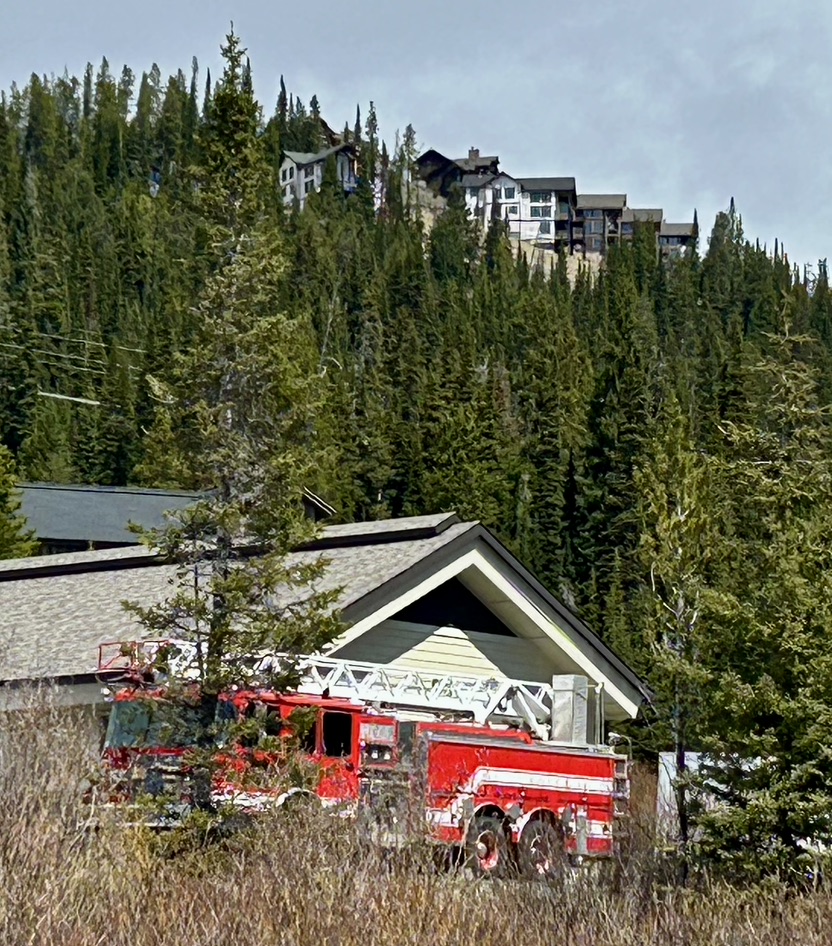
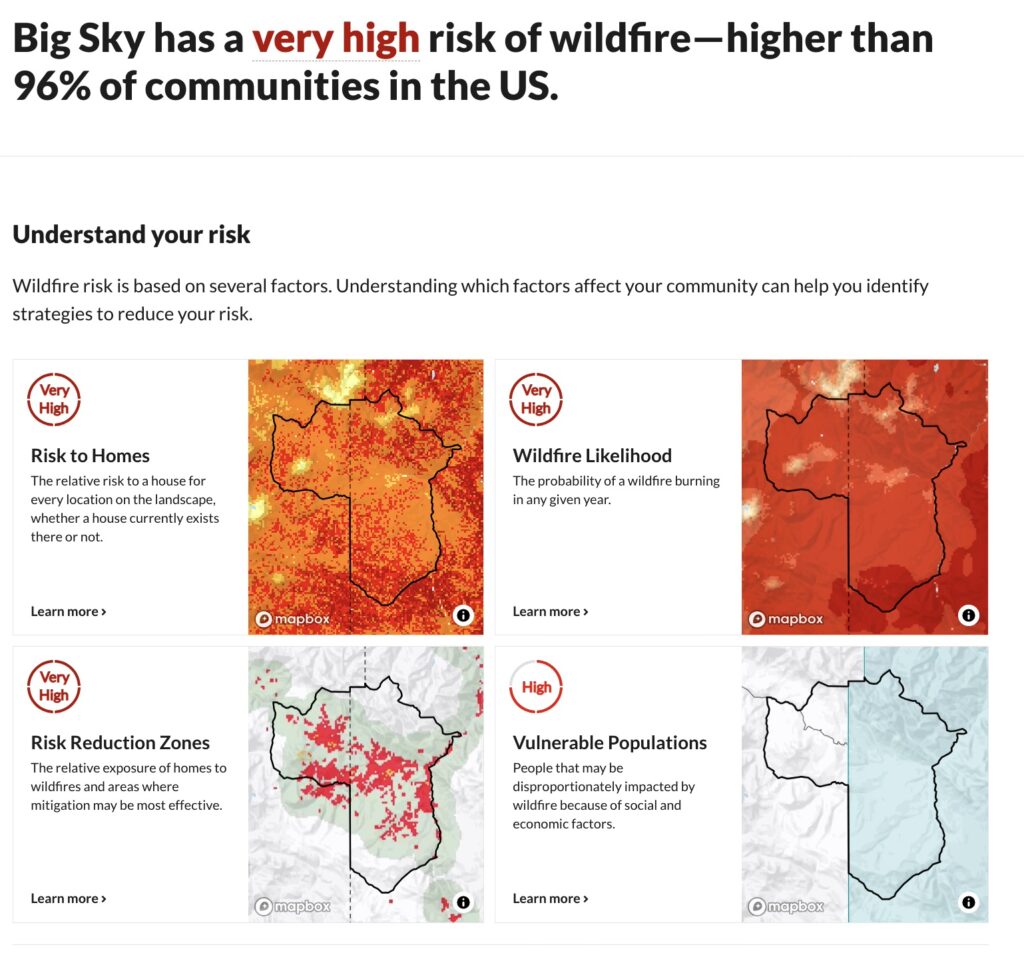
Also quoted in the Robb Report story that touted One and Only-Moonlight Basin resort was Tom Kundig, partner in the renowned Seattle architecture firm Olson Kundig that designed it. “To come into a landscape like this is almost like an invitation to a sacred situation, where it’s beautiful the way it is,” Kundig said in a video about Moonlight Basin. “How do you make architecture that actually unfolds itself into that landscape, but also doesn’t detract from that landscape? I could not imagine a higher honor at this point in my career, to help create a place like this with clients who are sensitive to maintaining the spirit of a landscape and the spirit of a local culture.”
One wonders what Kundig is referencing when he speaks of buildings that don’t detract from the beauty of natural terra firma and, at the same time, maintain the spirit of a landscape. Perhaps he would riff on that. What kind of a “sacred situation” is it that impairs the viability of wildlife habitat? Moreover, in Big Sky, it’s also unclear what the “spirit of local culture” is. Critics have argued that little wildness in Big Sky’s landscape has been treated as sacred.
Make no mistake, the enormous wealth present here has generously funded many cultural, arts, educational and social initiatives as well as facilities benefitting humans. And while it is easy to point fingers at single companies or individuals, and villainize them, that is not helpful or fair. The issue is a collective lack of awareness about the cumulative consequences of incremental decisions that, if they were made in a different, less-wildlife-rich part of the country, even Colorado or Utah—could be negligible and possibly praised.
Lone Mountain Land Company may have the highest profile in Big Sky yet it exists within a constellation of many entities involved with the exchange of billions of dollars in real estate value being bought, sold and flipped. Another, The Big Sky Real Estate Company which has as its major partners Big Sky Resort, Moonlight Basin and Spanish Peaks, is among dozens of land brokers, developers, architecture, interior decorator and construction firms constantly on the hustle.
In 2021, just months before the One and Only-Moonlight Basin project was formally unveiled, a writer for the Big Sky Real Estate Company’s website, which is devoted to promoting the Big Sky lifestyle, penned a narrative under the banner “Wildlife First.” Whoever the writer is used a curious, ironic choice of words. “Conservation works best when humans set aside key habitat for critters and consciously choose to build lightly on less sensitive ground. To do that effectively requires hiring scientists—and learning patience,” the unknown author wrote. “The theory behind conservation biology is pretty simple: Instead of tranquilizing and radio collaring wild animals and moving them around the landscape to reintroduce them or manage populations, you protect big parcels of land, connect those parcels with corridors, and let the animals reintroduce and manage themselves. Corridors are the key, and the Big Sky region, especially the stretch from Moonlight to Ennis, is rife with them.”
“The theory behind conservation biology is pretty simple: Instead of tranquilizing and radio collaring wild animals and moving them around the landscape to reintroduce them or manage populations, you protect big parcels of land, connect those parcels with corridors, and let the animals reintroduce and manage themselves.”
—A description of “conservation biology” as presented by the Big Sky real estate industry
Note to unknown author of the text above: that’s kind of a warped portrayal of conservation biology. And, the word “rife,” at least according to dictionary definition, has a pejorative connotation. The Cambridge Dictionary describes rife as “being full of something unpleasant.” Thus, does the writer really mean to suggest that the small wildlife corridors located between Moonlight and the town of Ennis in the Madison Valley, are that? Further, there’s not much “build lightly on less sensitive land” happening in Big Sky, nor are many wild animals succesfully reintroducing themselves into former habitat now covered with asphalt, concrete, glass and steel.
Land has been magnanimously protected. About 15,500 acres of Moonlight Basin was put under conservation easement by its individual landowners and another 2600 acres was put under easement by Lone Mountain Land Company when it purchased Moonlight in 2019. There’s also the 4500-acre Jack Creek Preserve, the result of a conservation easement, product of a 2005 deal struck between wildlife-minded landowners Jon Fossel and Dottie Fossel and the Montana Land Reliance. Even though those easements limit development and are saddled between the federal Lee Metcalf Wilderness, they are not totally insulated from the effects of sprawl now coming at the corridors from two directions.
Growing adjacent human pressures do not give wide-ranging wildlife a lot of room to safely wander, Schwartz told me in 2020. The late conservation biologist Brent Brock, who was enlisted to analyze the impacts of human development around Big Sky, expressed deepening concern in recent years. He noted that expanding sprawl occurring on unprotected lands in the Madison Valley between Ennis Lake/McAllister and pushing southward toward the outskirts of Ennis on the west side of the Madison Range was—and will—negatively impact the value of protected corridors. If outdoor recreation pressures also are happening on both public and private lands west of Big Sky, that puts added strains on wildlife and increases the likelihood of conflict.
“No areas have lost 100 percent of their diversity potential but a few areas have lost as much as 70 percent of their potential. Areas with the greatest impact occur in the area around Big Sky.”
—the late conservation biologist Brent Brock and five other scientists writing an exhaustive analysis on threats to a wide range of wildlife species in Madison County
In an exhaustive 2006 analysis Brock and five other scientists investigated threats to species persistence in the Madison Valley involving a wide range of wildlife. They completed the document for the Wildlife Conservation Society, Madison Valley Ranchlands Group and Craighead Environmental Research Institute. “No areas have lost 100 percent of their diversity potential but a few areas have lost as much as 70 percent of their potential,” they noted. “Areas with the greatest impact occur in the area around Big Sky…In addition, moderate degradation has occurred along the Jack Creek and North Meadow Creek drainages and within willow flats south of Ennis Lake.” They wrote that of priority areas for wildlife connectivity and protection of winter and summer range in major foothills of the Madison Valley, the Jack Creek drainage is the most imperiled. Of impacts on rare and federally protected wolverines, Brock wrote: “The most severe degradation [of habitat] is in the Big Sky area where development associated with ski resorts overlaps high quality wolverine habitat. Extensive snowmobiling activity in the non-wilderness areas of the mountains may be causing moderate but widespread habitat degradation in the area.” Brock told me in 2023, just months before he died, that the threat level to species identified 17 years earlier had turned more grave.
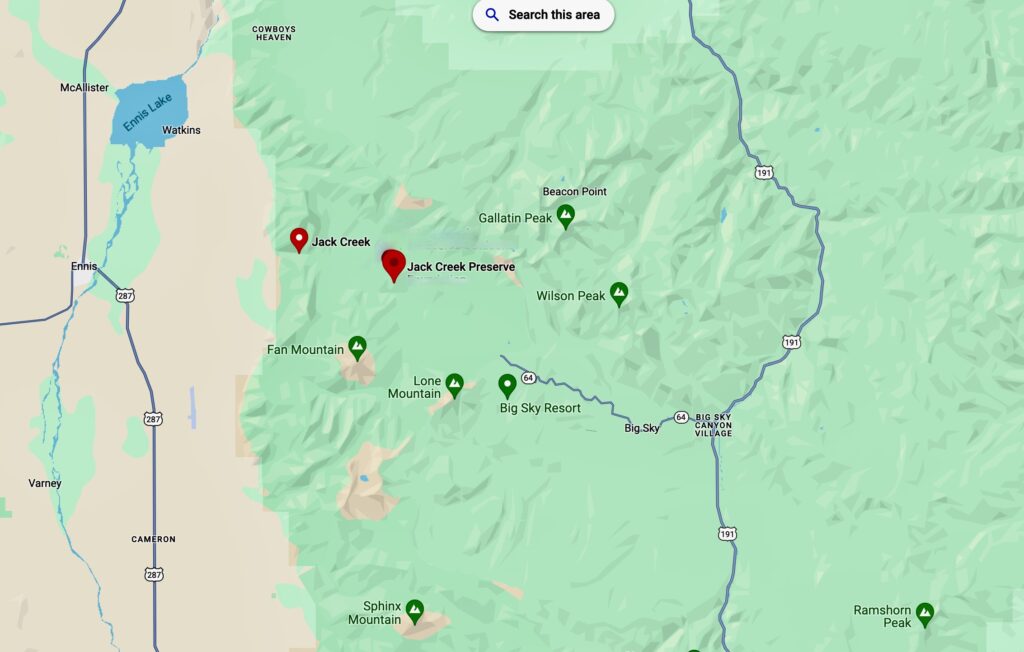
—————————————————————————————————————————————————————
Kidd and others hail a number of things being done on the sustainability front, including a slick-looking website wildbigsky.com that is supposed to represent a major contribution to promoting co-existence with wildlife. However, even a general perusal shows it lacks serious substance. The most profoundly beneficial thing Big Sky could do for wildlife, scientists say, is hold in check its appetite for development (which also exacerbates its self-inflicted affordable housing challenges facing working-class families and service workers).
Justin Farrell, author of the critically-acclaimed book Billionaire Wilderness: The Ultra-Wealthy and the Remaking of the American West, told me that for all the intelligent plutocrats in Big Sky, Jackson, and Bozeman he interviewed for his book, a surprisingly small percentage knew much about the ecology of the region. In addition, many are surprisingly stingy about supporting wildlife causes and journalism (like Yellowstonian) focused on long-term preservation of nature. Many see conservation as being radical, Farrell said. “They fail to grasp that for many of the earlier Americans they probably revere, the concepts of fiscal and political conservatism were intertwined with the ideals of land and wildlife conservation.”
It is safe to say, as a journalist who has lived in Greater Yellowstone and written about it for 38 years, that Park County residents do not wish to emulate Big Sky’s version of community. They prefer maintaining a quainter down-home, unpretentious ambiance. Lest one think that any reference to Big Sky is but a distant allusion, some here might be surprised to learn that Lone Mountain Land Company already has seized upon another development opportunity in the Shields Valley of northern Park County.
In 2021, Lone Mountain Land Company purchased the 18,000-acre Marlboro Ranch from Phillip Morris Company and rebranded it Crazy Mountain Ranch in deference to the spectacular Crazy Mountains, an island range, nearby. Believing that golf is an essential trapping in selling what Lone Mountain in its promotional materials has called “the Montana way of life,” it enlisted two time Masters Tournament champion Ben Crenshaw and business partner Bill Coore to design a sprawling 18-hole course. Its fairways were blazed into terrain that was readily used by elk, moose, mule deer and pronghorn. View video below. Crazy Mountain Ranch’s webpage reads: “As Incredible A Setting There Will Ever Be For The Game Of Golf.” Membership is invitation only.
We live in an age when there is a glut of golf courses but there is only one region in the Lower 48 that, because of its assemblage of wildlife, is worthy of being discussed as a functional “American Serengeti.” Like ski areas, which anchor real estate development on private land, so, too, can golf courses directly or even indirectly inspire people to want to live near them. In northern Park County, there is a surprising number of currently undeveloped 20-acre lots not far from Crazy Mountain Ranch. Will the ranch spur more transplants who want to live in the Shields Valley? Will county land use planners be ready if it does?
In some corners of the country, golf courses are closing or being de-commissioned. Natural areas which were converted into manicured fairways with non-native vegetation and requiring herbicides and large amounts of water to keep them green are being restored. The New York Times published a story earlier in 2024 saying that land trusts are now purchasing golf courses and turning them into “ecological life rafts” for wildlife and plants. Reporter Cara Buckley wrote: “The United States has more golf courses than McDonald’s locations and also has more than any other country, accounting for about 42 percent of all courses worldwide, according to the National Golf Foundation. That oversupply, coupled with development pressures, has led more golf courses to close than to open since 2006.” Still, Lone Mountain Land Company, as part of its business model, believes clientele will be more enticed to come to Montana if they can golf.
In the 1990s, Dennis Glick was the only environmentalist to show up at a county commission meeting reviewing approval for the Yellowstone Club.. He raised questions about how this development would negatively affect the future of Big Sky, its water and wildlife. His concerns were remarkably prescient. Glick worked then for the Greater Yellowstone Coalition and helped make it a leading watchdog in scrutinizing development on private lands. In fact, GYC was praised as one of the premiere regional conservation groups in the country.
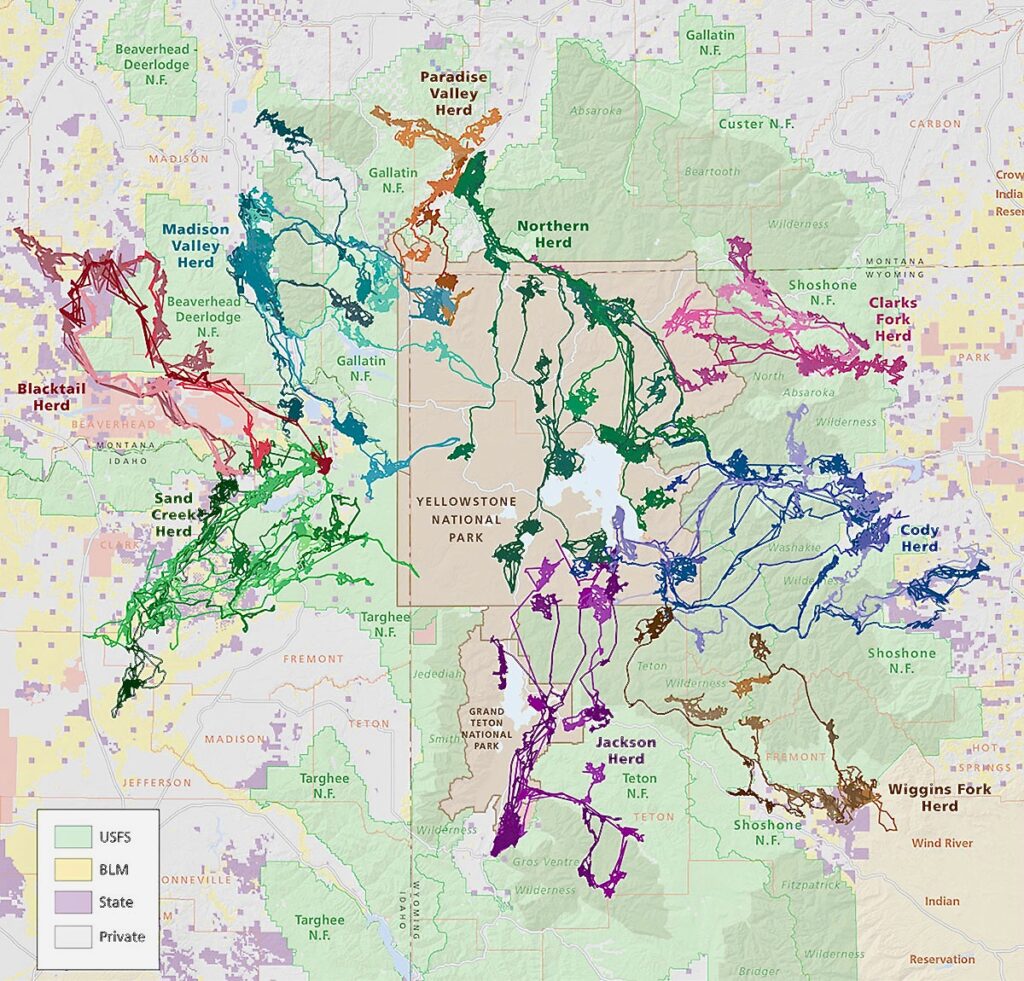
“I expressed concern about the impact that significant development [at Big Sky] would have over time on the Madison Range. And said that we needed to look at this cumulatively, given what had already happened at Big Sky. You can’t turn back the clock but you can be smarter looking forward,” Glick said. “What I always say about Big Sky is it only has three problems—location, location, location. When you put major development in the heart of a narrow mountain range, as occurred in the Madisons, the wildlife habitat and passageways animals use to move can easily become fragmented. And that’s exactly what has happened.”
Today, with a multi-million annual budget and four times the number of staffers present than when Glick served the organization, GYC made a decision to refrain from vigorously being involved in land use planning and zoning issues, which many of its former staffers and former supporters around the region say has been a huge mistake. Collaborating with ranchers is one thing, and it’s an example of soft conservation, but stopping massive subdivisions and leapfrog development sweeping across many of Greater Yellowstone’s rural valleys is equally as important.
With exurban sprawl having huge deleterious impacts on public lands, GYC, The Wilderness Society, Wild Montana (formerly the Montana Wilderness Association), Sierra Club and others have inexplicably not raised objections about the expanding footprint of Big Sky either. If major conservation organizations working in Greater Yellowstone are not actively engaged in planning and zoning issues, “then they are not helping to stop many of the biggest threats facing this ecosystem, Glick says. “Big Sky is one of the biggest environmental issues.” While it’s a private land issue—a planning and zoning issue, it’s a major concern for wildlife and nearby public lands. Every one of the high-growth counties in Greater Yellowstone are dealing with their own versions of Big Sky. Groups, he says, need to stop sitting on the sidelines.
“What I always say about Big Sky is it only has three problems—location, location, location. When you put major development in the heart of a narrow mountain range, as occurred in the Madisons, the wildlife habitat and passageways animals use to move can easily become fragmented. And that’s exactly what has happened.”
—Dennis Glick, a specialist in private land conservation and planning issues in the Northern Rockies for 40 years
Bozeman environmental lawyer Guy Alsentzer is not one who lies in the weeds. Protecting water is about protecting the lifeblood of ecology and even a truly sustainable economy that is compatible with its setting, he believes. Founder and executive director of Upper Missouri Waterkeeper, he and his small plucky team have sued to protect water quality in several of Montana’s famous rivers and scrutinize the link of its degradation to sprawl. Alsentzer says he has no patience for abiding what he calls “greenwashing and deflection related to the causes of pollution,” including recent algae blooms in the Gallatin River at Big Sky. For reasons that cannot be fully explained, he says, large environmental groups have given Big Sky’s sprawl a pass. Their conspicuous absence means Gallatin and Madison counties are not being pressed to uphold the highest standards under the law and it sends a signal, true or not, to the public that such issues are not important and that environmentalists must be condoning what’s happening.
“What we have with Big Sky is an extremely elite private land enclave, one of the richest in America, surrounded entirely by extraordinary federal public wildlands, not the least of which is nearby Yellowstone National Park. A responsible community would be working in support of preserving our common natural national heritage but that isn’t what happens,” Alsentzer said, echoing Glick. “What we’ve seen instead is a state and two county governments failing to uphold the public trust with the kind of development that has happened and likely will continue to happen up there. There is an obvious incoherent approach to land use, a purely reactionary approach to water protection and pollution control and a completely amorphous and absent approach to dealing with cumulative impacts on wildlife that are obvious.”
“What we have with Big Sky is an extremely elite private land enclave, one of the richest in America, surrounded entirely by extraordinary federal public wildlands, not the least of which is nearby Yellowstone National Park. There is an obvious incoherent approach to land use, a purely reactionary approach to water protection and pollution control and a completely amorphous and absent approach to dealing with cumulative impacts on wildlife.”
Environmental attorney Guy Alsentzer of Upper Missouri Waterkeeper
He went on, “The fundamental problem in Big Sky is there’s an irreconcilable difference between growth being perpetuated along with the intense human land use pressure that drives it and, on the other hand, trying to safeguard a wild healthy natural ecosystem that is one of a kind and fragile. This headwaters region has a very finite capacity to handle this kind of pressure and there needs to be a mechanism to cap it, but Big Sky is blowing straight through tipping points and few entities are calling it out. Water and wildlife are the canaries in the coal mine and the prospects for their future health isn’t good. Despite the rhetoric you hear, Big Sky is not a place that’s going to grow its way out of the problems it has created for itself. It’s an absurd premise.”
The level of dissatisfaction is greater than it appears and the fiercest defenders of Big Sky’s ceaseless growth are those capitalizing from it, he says. Essential to understand, Alsentzer adds, is that Big Sky fits the classic characteristics of a company town, as taught in business schools and college sociology classes. When certain special interests wield a disproportionate amount of say and swagger in local decisionmaking—in Big Sky, it’s real estate, the construction industry, developers and purveyors of outdoor recreation products—then certain concerns get minimized. From the perspective of American capitalism and business, development is creating jobs and delivering huge monetary private returns in the name of progress. Yes, progress, but progress toward what?
In recent years, commercial outdoor recreation interests based in Big Sky were among the voices who successfully pushed to limit the amount of national forest land being recommended for federal wilderness designation in the nearby Gallatin Range. Preservation that barred motorized recreationists and mountain bikers would harm their businesses, they said. Scientists, meanwhile, said Wilderness would be the most optimal classification of protection for the Gallatin Range’s world-class wildlife because it would buffer the impacts of Big Sky. Three major Montana conservation organizations sided with the commercial recreation interests in Big Sky.
Land and nature exist to be monetized; that’s the prevailing ethos of Big Sky. While there are a lot of people in the community who disagree with that mantra, they are reluctant to state it publicly, Alsentzer says. When it comes to conservation-minded Big Sky residents who feel they can’t speak up, the reason is they fear retaliation and social alienation. The consequences are potentially being left out of business opportunities or not being invited to attend social events and cocktail parties. The unspoken rule is that, in Big Sky, people are expected to go along to get along and never utter discouraging words that might rile the powers that be.
Not long ago, a retired environmentalist who figured prominently for decades in Greater Yellowstone land protection remarked snarkily, “You have to really wonder: is the TV show Yellowstone a fictional over-the-top melodrama or is it a clever mockumentary about the insatiable greed of real-life development in Montana and the lameness of conservationists in standing up to it? Chew on that for a moment.”
“You have to really wonder: is the TV show Yellowstone a fictional over-the-top melodrama or is it a clever mockumentary about the insatiable greed of real-life development in Montana and the lameness of conservationists in standing up to it? Chew on that for a moment.”
On several occasions, scriptwriters for Taylor Sheridan’s Yellowstone have cast aspersions directly at Big Sky, by name, through the show’s characters. The lead fictional protagonist, rancher John Dunton played by actor Kevin Costner, has delivered some memorable zingers in the first few seasons of the show. Maybe the most poignant came when the ranch patriarch ran for governor of Montana, and won, railing against what he said was unwanted change.
In one soliloquy written for the fictional anti-hero, Dutton said the following in response to bullying tactics being applied by Eastern developers pushing to build a massive destination resort in a fictional Paradise Valley north of Yellowstone for affluent tourists. Part of the high-end resort would require a hostile takeover of the Dutton Ranch and rolling right over local land use regulations. In response, the defiant, fictional Governor Dutton vows in a public speech aimed at those developers and others like them.
“The question is what you do and who you are. I’ll tell you the land’s only hope is for them [developers] to be a steward,” Dutton says. “The ugly truth is they want the land, and if they get it, it will never look like our land again. That’s progress in today’s terms. So, if it’s progress you seek, don’t vote for me. I am the opposite of progress. I’m the wall that it bashes against. And I will not be the one who breaks.”
A few years ago, I was having a conversation with a well-known realtor from Big Sky who asked me this question: “Name one thing you would do to try to save Big Sky?” I told him it wasn’t up to me; I am only a journalist, but I did bring the question to a half dozen experts I know who are renowned thinkers in large landscape conservation. To a person, each identified the same three things: establish a firm growth boundary around Big Sky immediately to stop the contagion of sprawl from spilling outward and further impairing the ecological function of adjacent public lands; impose a moratorium on new development; and act in ways that are sympathetic and sensitive to the survival of wildlife, recognizing the importance of migration routes, and heed what the science is saying without ignoring it in favor of reaping higher profits.
That realtor said he would take the recommendations back to influential people in the Big Sky community whom he said were sympathetic to wildlife conservation. People of means, he said; they could surely do something momentous. Of course, nothing ever came of it. What is certain is that eventually, someday, Big Sky will run out of buildable land and maybe fresh water. When the rich diversity of wildlife is gone, and no amount of wealth on Earth will be able to bring it back, where will its “spirit of landscape” and “spirit of local culture” be then?
EDITOR’S NOTE: In other parts of this series, we take a look at what the science says about the impacts of sprawl on wildlife and what it means for citizens and the counties of Greater Yellowstone.
Part 1 in this series: Of Gut Checks And Moments Of Truth: What happens when communities surrender their wildlife to sprawl? Outside Yellowstone and Grand Teton, Jackson Hole, Teton Valley, Bozeman, Big Sky, Island Park, and Madison Valley are wrestling with the question. Nowhere does it loom larger at the moment than in Park County and Paradise Valley.
Also read:
Wreckreation And Our National Obsession To Love Wild Places To Death
Subdivisions: As Impactful To Wildlife Over Time As Clearcuts, Mines And Energy Combined
What Happens When Greater Yellowstone’s Conservation Movement Goes MIA On Sprawl?
Meet The Real Madison—And Why It’s Called ‘A Mini-American Serengeti’
Refusing To Surrender Wild Ground—Citizens in the lower Madison Valley battle against sprawl
What’s Facing The Madison Valley? A Longtime Conservation Land Broker—Bob Kiesling— Weighs In
New Scientific Study Focuses On Largest Threat To Greater Yellowstone’s Iconic Wildlife
On The Front Doorstep To Yellowstone, A Montana County Wrestles With How To Confront Change by Randy Carpenter and Robert Liberty
Can the ‘Californication’ of Idaho Be Slowed? by Rob Harding

